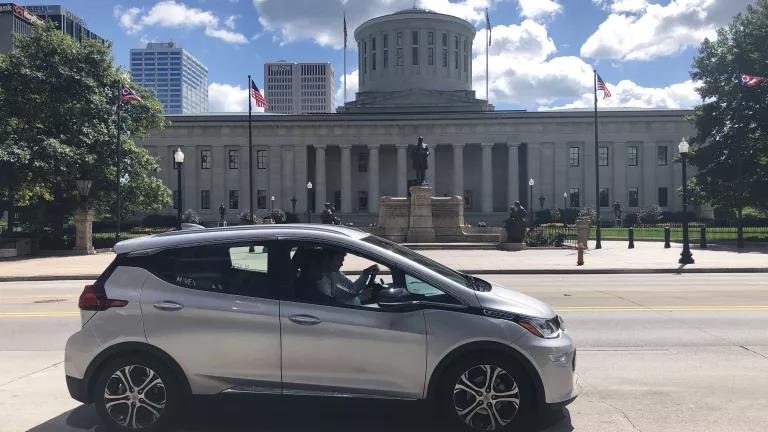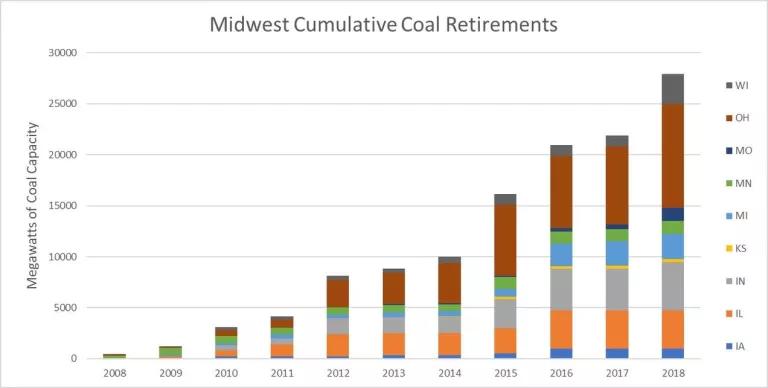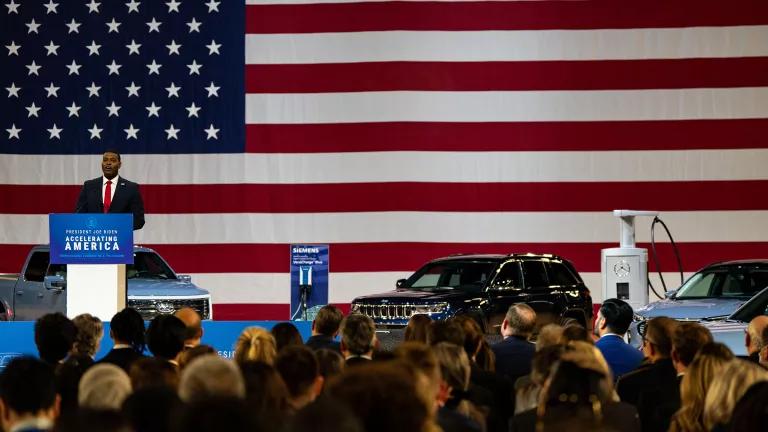State of the States: EVs and EV Policy in the Midwest

Transportation is the primary driver of carbon emissions in the United States. While declining renewable energy costs and shifting attitudes on climate have played a key role in de-carbonizing the power sector (and especially Midwest coal plants), the transportation sector has seen inconsistent progress. In a move that even automakers oppose, the Trump administration appears committed to a rollback of common-sense clean car and fuel economy standards that save drivers money, advance automotive technology, and drastically reduce air pollutant emissions.

Clean transportation presents the Midwest in particular with an unprecedented opportunity to revitalize its automotive economy. The region has long played a central role in the US automobile industry, and its EV sector already employs nearly 25,000 people. In fact, the Chevy Bolt – the very car we chose for our Midwest road trip—is manufactured at GM’s Orion Assembly plant right here in Michigan. The emerging electric truck and SUV maker Rivian, which has attracted hundreds of millions of dollars in investment from Amazon and Ford, manufactures its vehicles in Normal, Illinois—at a plant once owned by Mitsubishi.
And it’s not just about passenger cars. Workhorse, an electric truck maker that supplies UPS, DHL, Ryder and others clean and quiet delivery vehicles, is headquartered in Loveland, Ohio and manufactures in Indiana. Its growth – Workhorse is in talks to purchase the idle GM facility in Lordstown, Ohio and, in partnership with VT Hackney, is a finalist to supply the United States Postal Service with a clean fleet—demonstrates the potential that electrification of medium- and heavy-duty vehicles holds for the region’s economic vitality (and air quality).
As battery and vehicle costs continue to decline and driving ranges continue to increase, EVs will only offer stronger value propositions, thus creating more demand and more jobs. States, cities, and utilities must capitalize on this opportunity by supporting widespread adoption of these promising technologies. But to understand where we are going, we must understand where we are. Let’s examine the state of EVs and EV policies in the Midwest.

Michigan
In January, the Michigan Public Service Commission approved Consumers Energy’s PowerMIDrive Program, which will deploy $10 million to incentivize the development of charging stations at homes, apartments, schools, workplaces, and other key locations (including along highways). Shortly thereafter, the state’s commission approved Michigan utility DTE’s “Charging Forward” program, which enables a $13 million investment into charging infrastructure, school bus electrification, and consumer education. DTE’s program marked the largest ever EV charging infrastructure pilot in the Midwest.
Together, these investments will create thousands of new public charging stations within Michigan state lines, significantly shifting the state’s electrification landscape and bolstering options for electric vehicle drivers. Moreover, as our colleague Max Baumhefner notes, “Lots of potential electric vehicle customers are locked out of the market because they live in apartment buildings that don’t have a place to plug in.”
Thankfully, these programs will add charging stations where they are needed and help people who don’t live in single-family homes to choose EVs as a cleaner, cheaper alternative to gas guzzlers.
Illinois
Illinois established itself as a clean energy leader with the passage of the 2016 Future Energy Jobs Act (FEJA), which has driven substantial investment into renewable energy in the state and diversified the communities that benefit from clean energy generation through programs like Illinois Solar for All. But there is more work to do in the state—and many more benefits to be realized with EVs.
A 2017 analysis commissioned by Charge Up Midwest and conducted by MJ Bradley and Associates, for example, found that Illinois could accrue approximately $43 billion in cumulative benefits by 2050 as a result of widespread EV adoption. The most substantial benefits would flow from savings resulting from EV costs relative to gasoline vehicle costs, reduced greenhouse gas emissions, and reduced utility bills as EV integration strengthens the grid and puts downward pressure on electricity rates.
Fortunately, there is a fairly clear path forward to achieving these outcomes. Illinois can advance its clean energy goals by passing the Clean Energy Jobs Act (CEJA), which would reaffirm the state’s commitment to decarbonization by ramping to 100 percent renewable energy by 2050. The bill’s transportation provisions would eliminate the equivalent of one million gasoline-fueled vehicles through new incentives and infrastructure. CEJA would also look beyond light-duty transportation (passenger cars and trucks) to advance electric medium- and heavy-duty transportation vehicles, such as large trucks and equipment that tend to run on diesel and are responsible for significant, negative health impacts in environmental justice communities with heavy truck traffic.
Ohio
In April 2018, the Public Utilities Commission of Ohio approved American Electric Power (AEP) Ohio’s plan to invest $10 million to develop 375 charging stations at homes, apartment buildings, workplaces, and various public locations. Ohio is also making good use of its funds from the Volkswagen settlement by committing more than $14 million to deploy charging infrastructure and electric public buses in the state.
Ohio’s transportation electrification efforts are particularly noteworthy given other recent energy developments in the state. Last month, under pressure from Trump re-election campaign staffers, the state legislature passed a plan that would eliminate the state’s renewable portfolio standard (RPS) while throwing a lifeline to the state’s nuclear and coal plants. This comes despite a recent Massachusetts Institute of Technology (MIT) analysis that found that the RPS delivers an annual net health benefit of more than $170 million to Ohioans and prevents premature deaths.
Missouri
Kansas City Power and Light’s Clean Charge Network includes more than 1,000 EV chargers throughout the greater Kansas City Region. The state’s Public Service Commission also approved Ameren Missouri’s plan to invest more than $4 million into charging infrastructure along highways in and around St. Louis in early 2019.
Minnesota
A report from MJ Bradley and Associates examining Minnesota’s transportation electrification potential found that the state could realize more than $30 billion in cumulative benefits by 2030 through widespread EV adoption. The Minnesota Public Utilities Commission has itself acknowledged that the state has a significant interest in accelerating the electrification of its transportation sector.
The state’s utilities are also charging forward, with Xcel Energy having several programs approved by the commission. The utility has committed a total of $25 million for public chargers, community mobility hubs, and chargers to aid in electrifying the government’s transportation fleet. There’s also a smaller 100 person pilot for residential charging installation through Xcel.
Conclusions
The Midwest’s tradition of transportation innovation and untapped clean energy potential position the region to lead on transportation electrification. This blog outlines steps that states, cities, and utilities have taken to accelerate clean transportation. But there’s more to do. By further de-carbonizing transportation, the Midwest can reap the full range of benefits that electrification offers. It can maintain its legacy of technological innovation in the face of the 21st century’s economic realities.
Transportation electrification promises new jobs, better air quality, better human health, reduced fuel costs, reduced utility rates, and reduced greenhouse gas emissions—all while Midwesterns take smooth and silent rides, like ours, around the Great Lakes and Great Plains.



